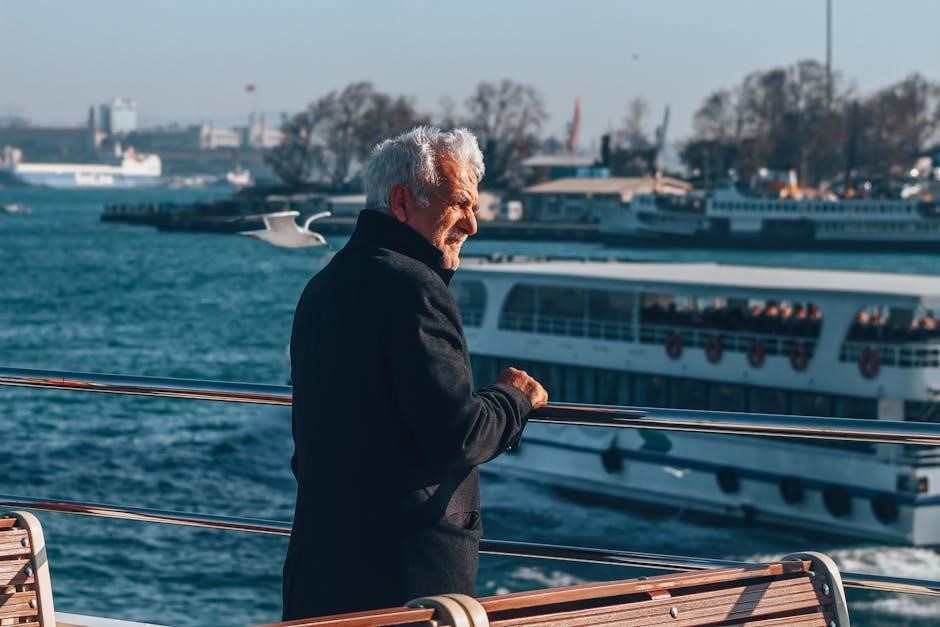“The Old Man and the Sea” by Ernest Hemingway, published in 1952, tells the story of aging fisherman Santiago’s journey and epic battle with a giant marlin, symbolizing perseverance. The novella earned Hemingway a Pulitzer Prize, solidifying its literary significance. PDF versions are widely available for educational purposes.
1.1 Overview of the Novella
“The Old Man and the Sea” is a novella by Ernest Hemingway, published in 1952, recounting the journey of Santiago, an aging Cuban fisherman. After 84 days without catching fish, Santiago ventures into the Gulf Stream, encountering a massive marlin. The story explores themes of perseverance, human struggle, and the interconnectedness of life and nature. The novella is celebrated for its concise prose and deep emotional resonance, earning Hemingway the Pulitzer Prize in 1953. Its universal appeal has made it a timeless classic in world literature.
1.2 Historical Context and Background
Written in 1952, “The Old Man and the Sea” reflects Ernest Hemingway’s experiences as a big-game fisherman and his deep connection to Cuba. The novella was composed during a period of personal and professional challenges for Hemingway, including aging and declining health. Set against the backdrop of post-World War II, the story captures themes of resilience and human struggle, resonating with readers globally. Its publication revitalized Hemingway’s career and solidified his literary legacy, earning him the Pulitzer Prize in 1953.

1.3 Ernest Hemingway’s Writing Style
Ernest Hemingway’s writing style in “The Old Man and the Sea” is characterized by simplicity, clarity, and a focus on action over description. His minimalist prose, known as the “Iceberg Principle,” leaves much unsaid, allowing readers to interpret deeper meanings. Hemingway’s use of short sentences and direct language creates a sense of immediacy, while his emphasis on human struggle and nature reflects his broader philosophical themes. This style, combined with vivid imagery, has made the novella timeless and universally relatable, solidifying Hemingway’s reputation as a literary giant.

Plot Summary of “The Old Man and the Sea”
The novella follows Santiago, an aging fisherman, as he battles a giant marlin off Cuba. After 84 days without a catch, Santiago’s luck changes when he hooks a massive fish, leading to a prolonged struggle. Despite his physical limitations, Santiago’s determination and resilience shine through. Ultimately, sharks destroy the marlin, leaving Santiago with only its skeleton. The story explores themes of perseverance, nature, and the human condition, culminating in a poignant reflection on life and defeat.
2.1 The Setting of the Story
The story is set in the Gulf Stream near Cuba and the village of Cabo Blanco. Santiago, the old fisherman, ventures into the deep waters, where the warm currents of the Gulf Stream teem with marine life. The setting emphasizes isolation and the vastness of nature, contrasting the small skiff with the immense ocean. The marine environment is vividly described, from the clarity of the water to the movements of the fish, creating a backdrop for Santiago’s epic struggle. The setting highlights themes of man versus nature and survival in a challenging ecosystem.
2.2 Key Events in the Narrative
The narrative unfolds with Santiago, an aging fisherman, enduring 84 days without a catch. He ventures far into the Gulf Stream, where he hooks a massive marlin. Over several days, Santiago battles the marlin, exemplifying his determination and skill. The marlin eventually dies, and Santiago secures it to his boat. However, during his return, sharks attack the carcass, leaving only the skeleton. Santiago’s journey symbolizes perseverance, loss, and the human struggle against nature, leaving a profound impact on the reader.
2.3 The Resolution and Its Significance
Santiago returns to shore with only the marlin’s skeleton, symbolizing his perseverance despite ultimate loss. The skeleton serves as a testament to his epic struggle, inspiring awe in the villagers. Santiago’s journey reflects themes of resilience, sacrifice, and the human condition. The resolution underscores the idea that true value lies in the effort, not the outcome. Santiago’s experience rejuvenates his spirit, emphasizing that defeat is not the end but a part of life’s cycle. The novella concludes with Santiago ready to face new challenges, embodying enduring hope and determination.
Major Themes in “The Old Man and the Sea”
The novella explores themes of perseverance, friendship, and man vs. nature. Santiago’s journey symbolizes the human struggle, resilience, and existential reflection on life’s purpose and meaning.
3.1 Perseverance and Determination
In “The Old Man and the Sea,” Santiago’s unwavering resolve exemplifies perseverance. Despite enduring a massive marlin’s struggle and shark attacks, he remains determined. His journey reflects the human spirit’s capacity to endure suffering and persist against overwhelming odds. Hemingway’s portrayal underscores Santiago’s unyielding will, even in the face of defeat, highlighting resilience as a central theme. PDF versions of the novella provide insight into Santiago’s character, emphasizing his determination and the universal appeal of his struggle.
3.2 Friendship and Isolation
The themes of friendship and isolation are deeply intertwined in The Old Man and the Sea. Santiago’s bond with the young boy Manolin highlights his emotional connection, contrasting with his solitary journey at sea. Despite his isolation, Santiago finds companionship in nature and memories, showcasing resilience. The novella explores how friendship provides strength, even in solitude. PDF versions of the story emphasize Santiago’s dual existence, blending human connection with the vast, isolating ocean, creating a poignant reflection on loneliness and camaraderie.
3.3 Man vs. Nature
The struggle between man and nature is central to The Old Man and the Sea. Santiago’s epic battle with the marlin symbolizes humanity’s defiance against the vast, untamed natural world. The marlin represents both beauty and overwhelming power, while Santiago embodies resilience and determination. The novella explores the delicate balance between human effort and the indomitable forces of nature, ultimately revealing a profound respect for both. PDF versions of the story highlight this timeless conflict, emphasizing Santiago’s journey as a universal metaphor for human perseverance against the elements.
3.4 The Human Struggle and Existentialism
The Old Man and the Sea delves into the existential themes of human struggle and the search for meaning. Santiago’s journey represents the universal human condition, where individuals face inevitable suffering and adversity. The novella explores the idea that life inherently lacks meaning, but individuals create purpose through their actions and perseverance. Santiago’s solitary struggle, even in the face of defeat, underscores the existential belief that the act of striving itself is what gives life significance. PDF versions of the story often highlight these philosophical undertones, resonating deeply with readers searching for existential truths.

Character Analysis
Santiago, the determined old fisherman, embodies resilience and wisdom. Manolin, the loyal boy, represents hope and admiration, while the marlin symbolizes the majestic struggle of nature.
4.1 Santiago: The Old Man
Santiago, the aging fisherman, is a symbol of resilience and determination. After 84 days without catching fish, he ventures into the Gulf Stream, driven by hope and experience. His journey reflects a deeper struggle against nature and personal doubt. Despite his physical frailty, Santiago’s mental strength and wisdom shine through. Hemingway portrays him as a complex figure, blending humility with pride, and a profound connection to the sea. Santiago’s character embodies the essence of perseverance in the face of adversity, making him a timeless literary icon.
4.2 The Young Boy (Manolin)
Manolin, the young boy, represents hope and loyalty in Santiago’s life. Despite the villagers’ belief that Santiago is unlucky, Manolin remains devoted, bringing him food and supplies. Their bond transcends generations, with Manolin looking up to Santiago as a mentor. After Santiago’s epic journey, Manolin stays by his side, symbolizing unwavering friendship. Manolin’s character highlights the theme of companionship and the passing of wisdom from old to young, enriching the narrative with emotional depth and human connection.
4.3 The Marlin as a Symbolic Character
The marlin in The Old Man and the Sea is a powerful symbolic figure, representing both nature’s majesty and the elusive essence of life. It embodies grace, strength, and the unattainable, pushing Santiago to his limits. The marlin’s epic struggle with Santiago symbolizes man’s perseverance against overwhelming odds. Its eventual destruction by sharks highlights the inevitability of decay and the harshness of life. The marlin’s journey alongside Santiago becomes a metaphor for the human quest for meaning and the eternal battle between will and nature.

Literary Devices and Symbolism
Hemingway employs minimalism, vivid imagery, and profound symbolism to explore themes like perseverance and human struggle, enriching the narrative with layered meaning and emotional depth.
5.1 Use of Imagery and Descriptions
Hemingway’s vivid imagery immerses readers in Santiago’s world, using concise yet powerful descriptions of the sea, weather, and the old man’s physical state. The marlin’s majesty and the sharks’ brutality are depicted with striking clarity, enhancing the narrative’s emotional depth. Santiago’s hands, creased and scarred, symbolize his resilience. The sea itself is personified, reflecting Santiago’s moods and struggles. This imagery creates a strong visual connection, drawing readers into the old man’s journey and emphasizing his battle with nature.
5.2 The Symbolism of the Marlin
The marlin in The Old Man and the Sea symbolizes challenge, nobility, and the uncontrollable forces of nature. Santiago’s epic battle with the marlin represents his struggle against fate and the natural world. The marlin’s enormous size and beauty underscore its role as a worthy adversary, embodying the dignity and power of life. Through the marlin, Hemingway explores themes of courage, perseverance, and the human spirit’s capacity to endure adversity, even in the face of inevitable loss.
5.3 The Role of the Sharks
The sharks in The Old Man and the Sea symbolize destruction, inevitability, and the natural order of life. They arrive after Santiago’s triumph, devouring the marlin and leaving only its skeleton. This serves as a stark contrast to Santiago’s achievement, highlighting the transient nature of success. The sharks represent the harsh realities of existence, where even the greatest struggles can lead to loss. Their presence underscores the futility of human efforts against the indomitable forces of nature, yet also emphasizes Santiago’s resilience and dignity in the face of defeat.

Ernest Hemingway’s Writing Style
Hemingway’s writing is concise, direct, and powerful, focusing on simplicity and clarity to convey deep emotional and philosophical themes through precise language and understatement.
6.1 The Iceberg Principle
Hemingway’s “Iceberg Principle” is evident in The Old Man and the Sea, where most of the narrative’s depth lies beneath the surface. The story’s simplicity belies its rich emotional and philosophical undertones. Hemingway masterfully omits explicit descriptions of Santiago’s inner turmoil, instead conveying his resilience and determination through subtle actions and dialogue. This technique engages readers by inviting them to interpret the unspoken, making the novella both powerful and thought-provoking. The principle underscores Hemingway’s minimalist style, allowing the story to resonate deeply without overt elaboration.
6.2 Minimalist Prose and Conciseness
Hemingway’s The Old Man and the Sea exemplifies minimalist prose, characterized by simplicity and brevity. The novella’s concise language avoids unnecessary embellishments, focusing on direct, impactful sentences. This style creates a sense of immediacy, drawing readers into Santiago’s journey. Hemingway’s ability to convey profound themes through sparse, precise wording underscores the narrative’s emotional depth. The minimalist approach ensures clarity, making the story accessible while maintaining its lyrical and symbolic richness. This conciseness is a hallmark of Hemingway’s writing and central to the novella’s enduring appeal.
6.3 Use of Dialogue and Monologue
Hemingway employs dialogue and monologue sparingly in The Old Man and the Sea, reflecting Santiago’s solitude. Conversations with Manolin are brief yet meaningful, highlighting their bond. Santiago’s monologues, often directed at the marlin or himself, reveal his introspection and determination. These internal dialogues emphasize his connection to nature and his unyielding spirit. Hemingway’s use of dialogue and monologue enhances character depth, underscores themes of perseverance, and maintains the novella’s intimate, reflective tone, drawing readers closer to Santiago’s emotional journey.

Cultural and Historical Significance
The Old Man and the Sea reflects post-war resilience and the human struggle, resonating universally. Its themes of perseverance and nature transcend cultures, making it a timeless classic.
7.1 The Novella’s Impact on Literature
The Old Man and the Sea profoundly influenced 20th-century literature, showcasing Hemingway’s minimalist style and universal themes. Its concise yet powerful narrative inspired authors worldwide, emphasizing simplicity and depth. The novella’s exploration of human struggle and existentialism reshaped literary perspectives, making it a cornerstone of modernist fiction. Its impact is evident in its enduring popularity and adaptation across media, solidifying its place as a timeless literary masterpiece that continues to inspire writers and readers globally.
7.2 Hemingway’s Legacy and Influence
Ernest Hemingway’s legacy endures as a literary icon, with The Old Man and the Sea cementing his reputation as a master of minimalist storytelling. His distinctive writing style, emphasizing clarity and emotional depth, has influenced generations of authors. Hemingway’s focus on courage, resilience, and the human condition set a new standard for literary themes. His work transcended literature, inspiring adaptations in film, art, and popular culture, ensuring his enduring impact on creative expression and storytelling techniques worldwide.
7.3 The Story’s Universal Appeal
The Old Man and the Sea captivates readers worldwide with its universal themes of perseverance, hope, and the struggle between humanity and nature. Santiago’s journey resonates across cultures, ages, and backgrounds, making it a timeless tale. The simplicity of Hemingway’s prose, combined with the depth of its symbolism, allows readers to connect on personal levels. Its exploration of existentialism and the human condition ensures the story’s enduring relevance, fostering empathy and reflection in audiences globally.

Adaptations and Interpretations
The Old Man and the Sea has been adapted into films, stage plays, and cultural interpretations, preserving its essence while exploring new creative dimensions, as seen in the PDF version.
8.1 Film Adaptations of the Novella
The novella has inspired several film adaptations, including the 1958 version starring Spencer Tracy and the 1990 film featuring Anthony Quinn. These adaptations capture the essence of Santiago’s journey, blending drama and visual storytelling. While faithful to Hemingway’s narrative, they also offer unique interpretations of the old man’s struggle. The films, like the PDF version of the book, provide a vivid exploration of themes such as perseverance and the human connection with nature, ensuring the story’s timeless appeal across different media formats.
8.2 Stage Play Adaptations
The novella has been adapted into stage plays, bringing Santiago’s journey to life through theatrical interpretations. A notable adaptation is the Broadway production, which captures the emotional depth of the old man’s struggle. The play emphasizes themes of perseverance and the human bond with nature. Minimalist sets and powerful dialogues reflect Hemingway’s concise style, while the marlin and sharks serve as symbolic elements. These adaptations maintain the story’s essence, offering audiences a unique perspective on Santiago’s enduring spirit and universal themes, appealing to both longtime fans and new audiences alike.
8.3 Artistic and Cultural Interpretations
The novella has been adapted into stage plays, bringing Santiago’s journey to life through theatrical interpretations. A notable adaptation is the Broadway production, which captures the emotional depth of the old man’s struggle. The play emphasizes themes of perseverance and the human bond with nature. Minimalist sets and powerful dialogues reflect Hemingway’s concise style, while the marlin and sharks serve as symbolic elements. These adaptations maintain the story’s essence, offering audiences a unique perspective on Santiago’s enduring spirit and universal themes, appealing to both longtime fans and new audiences alike.
Critical Reception and Reviews
“The Old Man and the Sea” received widespread critical acclaim for its poignant themes and Hemingway’s minimalist prose. It revitalized Hemingway’s career and solidified his literary legacy, leading to the Nobel Prize in Literature in 1954. Critics praised its universal appeal and emotional depth, making it a timeless classic in modern literature.
9.1 Initial Reception in 1952
Upon its release in 1952, The Old Man and the Sea garnered immediate acclaim for its simplicity and emotional depth. Critics praised Hemingway’s return to form, hailing it as a triumph after a period of declining reputation. The novella resonated with readers worldwide, its themes of resilience and human struggle striking a chord. Serialized in Life magazine, it reached a vast audience, solidifying its place as a modern classic and earning Hemingway the Pulitzer Prize in 1953, followed by the Nobel Prize in Literature in 1954.
9.2 Modern Critical Analysis
Modern critics continue to praise The Old Man and the Sea for its profound exploration of existential themes and human resilience. The novella is celebrated for its minimalist prose, which conveys deep emotional and philosophical complexity. Scholars often analyze Santiago’s journey as a metaphor for the human condition, emphasizing themes of perseverance, dignity, and the inevitability of struggle. Postcolonial and feminist critiques have also emerged, offering diverse interpretations of the text. Hemingway’s sparse yet evocative writing style remains a focal point of admiration and study in contemporary literary analysis.

9.4 Audience Reception and Popularity
The Old Man and the Sea remains widely popular, resonating with readers globally. Its universal themes of perseverance and the human struggle against nature appeal to diverse audiences. The novella’s simplicity and depth have made it accessible to both casual readers and scholars. The PDF version has further boosted its reach, allowing easy access to Hemingway’s masterpiece. Readers often connect with Santiago’s resilience, making the story a timeless favorite. Its enduring popularity reflects its ability to inspire and evoke reflection across generations.
Educational Resources and Study Guides
The Old Man and the Sea is supported by numerous educational resources, including PDF guides, analysis tools, and teaching aids. These materials enhance understanding and facilitate deeper exploration of the novella’s themes, characters, and literary devices. Educators and students benefit from structured study guides that provide context, discussion questions, and critical insights, making the novella accessible and engaging for academic purposes.
10.1 PDF Versions and Digital Availability

The Old Man and the Sea is widely available in PDF format, offering convenient access for readers and educators. Platforms like Google Books, online libraries, and educational websites provide downloadable versions, often for free or at minimal cost. These digital editions are ideal for e-readers and mobile devices, ensuring easy portability and readability. Many PDFs include annotations, introductions, or study notes, enhancing the learning experience. Students and educators can access these resources to delve into Hemingway’s masterpiece with modern convenience and flexibility.
10.2 Study Guides and Analysis Tools
Study guides and analysis tools for The Old Man and the Sea are abundant online, offering in-depth insights for students and scholars. Websites like SparkNotes and LitCharts provide detailed summaries, character analyses, and thematic explorations. These resources often include essay questions, discussion prompts, and critical perspectives to aid understanding. Additionally, interactive tools such as timelines, quizzes, and annotated versions help readers engage deeply with the text. Educators and learners can leverage these tools to enhance comprehension and facilitate meaningful discussions about Hemingway’s timeless novella.
10.3 Teaching Resources for Educators
Educators can access a variety of teaching resources for The Old Man and the Sea, designed to enhance classroom engagement. Lesson plans aligned with curriculum standards are widely available, offering structured activities and discussion prompts. Printable worksheets focus on vocabulary, comprehension, and critical thinking. Teachers can also utilize interactive activities, such as character mapping and thematic analysis, to deepen students’ understanding. Additionally, multimedia resources like videos and podcasts provide alternative learning avenues, fostering a richer exploration of Hemingway’s timeless narrative.
